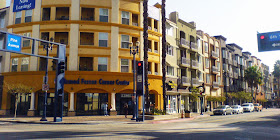MIXED-USE DEVELOPMENT: AN EXPLODING TREND
 |
| The mixed-use Portwalk development project in the City of Portsmouth, N.H. |
Very few professional trade magazines are free these days. But there is one that I receive and enjoy reading. It’s a publication by the Door and Hardware Institute and simply entitled “Doors & Hardware.” Each month I faithfully read each issue from cover to cover; the September 2012 issue was no exception. This month’s issue is dedicated to the growing trend in the construction industry for mixed-use development. For the benefit of the regular readers of this blog that are not architects, this term simply means that instead of segregating different occupancies like housing (residential), stores (retail), and office (commercial) space into separate isolated communities (called zones), we collocate them in one structure or cluster them in one development. At one time, that is how our cities developed: apartments were located above stores and worker housing was constructed immediately adjacent to the factories. But with the development of trollies, light rail, and eventually the invention of the automobile, the character of our cities began to change with the development of the outlying suburbs by people that wished to escape the undesirable living conditions of the city. So now, we’re actually beginning to see a return to a type of development that we once had.
 |
| Mixed-use development in California |
While on the surface the renewed interest in mixed-use development seems to satisfy what the public wants these days, it does present challenges to architects and developers because the requirements for each of these groups can conflict – particularly with regard to life safety (how we get everyone out of the building in the event of an emergency), sound attenuation, and security. In some instances, today’s building codes require that these different occupancy types be isolated from one another by fire-resistive construction, which can be expensive. But here’s what I found interesting. The drivers of this type of construction are: the public’s desire for “green” construction, the desire to meet the growing demands of the younger generation, and society’s demands for less time spent on the road. Each of these points will be discussed in separate posts.

No comments:
Post a Comment